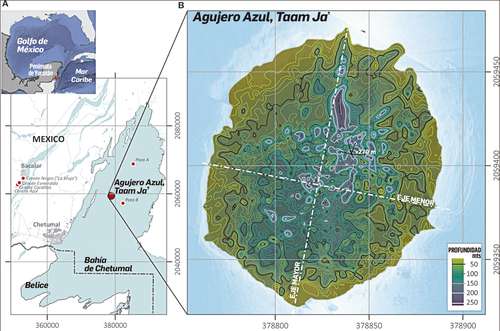
They discovered a blue hole in the bay of Chetumal, the second deepest in the world
▲ The triptych with the measurements and location of the blue hole, taken from frontiersin.org.Photo Joan Alberto Sánchez Sánchez
 ▲ The waters of Taam Ja’ are greenish due to the shallowness of the sea inlet and the whitish sediment of the bedPhoto Joan Alberto Sánchez Sánchez
▲ The waters of Taam Ja’ are greenish due to the shallowness of the sea inlet and the whitish sediment of the bedPhoto Joan Alberto Sánchez Sánchez
angel vargas
Newspaper La Jornada
Thursday March 23, 2023, p. 2
An interdisciplinary team of Mexican scientists from El Colegio de la Frontera Sur (Ecosur) discovered on the seabed of the bay of Chetumal, Quintana Roo, the second blue hole or deepest blue hole in the world, 274 meters.
The discovery and its details were disclosed in the most recent edition of the magazine Frontiers in Marine Science, after an investigation work that corroborated the depth of that body, whose mouth is oval in shape and covers an area of 152 meters long by 124 meters wide, the equivalent of one and a half professional football fields.
These marine bodies or cavities receive their name from the change in color that the water acquires, more intense or dark in relation to the tone that surrounds it, due to the depth they reach. It is a technical term adopted in the scientific field on an international scale.
In the case of blue hole of the bay of Chetumal, baptized as Taam Ja’, which in Mayan means deep water, presents a greenish hue due to the shallowness of that sea inlet and the whitish sediment of the seabed, details Juan Carlos Alcérreca Huerta, coordinator of the project and the publication, who specifies that its location is 4.5 kilometers from the coast of the town of Calderitas and about 18, in a straight line, from the city of Chetumal.
According to the doctor in engineering and researcher of the National Council of Science and Technology (Conacyt), the existence of this blue hole had been known for a long time by the inhabitants of that town in the southeast of Mexico, but it was in September 2021 when the Ecosur specialists were notified of it by the community guide Jesús Artemio Poot Villa.
It is a find of great relevance for marine scientific research, as it represents a window to obtain information on what the environment and climate were like thousands of years ago, which can help to understand environmental and geological processes, the connectivity of aquifers and the origin of water of these hydrogeological systems
according to information from Conacyt.
He blue hole
The deepest in the world that has been reported is Sansha Yongle, in China, with a depth of 300 meters below sea level; In second place until now was the so-called Dean Blue Hole, in the Bahamas, with 200 meters. Until the discovery in Chetumal, the deepest hole in the Caribbean region was the Great Blue Hole, in Belize, at 127 meters.
In interview with The Day, Juan Carlos Alcérreca Huerta points out that until before the discovery of Taam Ja’ it was believed that only cenotes existed in the Yucatan Peninsula, with which, in fact, blue holes share the same formation process, for karstification –consisting of the dissolution of limestone rock due to the action of water–, although they differ in that they contain predominantly marine liquid, not sweet, like cenotes.
 ▲ The interdisciplinary team of Mexican scientists from El Colegio de la Frontera Sur, made up of Óscar Fabián Reyes Mendoza, Joan Alberto Sánchez Sánchez, Teresa Álvarez Legorreta and Laura María Flores-Franco.Photo Joan Alberto Sánchez Sánchez
▲ The interdisciplinary team of Mexican scientists from El Colegio de la Frontera Sur, made up of Óscar Fabián Reyes Mendoza, Joan Alberto Sánchez Sánchez, Teresa Álvarez Legorreta and Laura María Flores-Franco.Photo Joan Alberto Sánchez Sánchez
Another characteristic is that its depth or the entire structure (of blue holes) develops below sea level. In the case of the Chetumal bay, it is from five meters below.
According to the researcher, it is very possible that the Taam Ja’ in an earlier time it may have been a cenote, as we all know it, but when the sea level rose it flooded the region and was covered by seawater. We are talking about the Ice Age, about 10,000 years ago.
.
Although the research undertaken by the scientific team in the aforementioned blue hole did not focus on the biological aspect, the data obtained by measuring the quality of the water rule out the existence of conditions for marine life to develop there.
Oxygen levels are very low, so they would not allow housing what we would call macrofauna or fauna such as fish or other beings that require oxygen to live. What was found, fundamentally, were films of bacteria and algae; that is, microfauna and microorganisms
he explained.
We do not know what other types of living beings can be found inside or at greater depths. What we do know is that they would be under anoxic conditions or practically without oxygen. That is another peculiarity of blue holes, which are very deep.
Taam Ja’ covers an approximate area of 13,690 square meters. Its sides are steep, with 80 degree slopes that form the structure of a large cone covered by biofilms, sediments, limestone, and gypsum overhangs.
The investigation was carried out using diving, echo sounders and conductivity, temperature and depth (CTD) profilers and the collection of water samples in September 2021.
The scientific team was made up of Teresa Álvarez Legorreta, Laura Carrillo, Laura Flórez Franco, Óscar Reyes Mendoza and Joan Alberto Sánchez Sánchez, as well as Juan Carlos Alcérreca Huerta, academics from Ecosur’s Chetumal Unit.
The article is at https://www.frontiersin.org/articles/10.3389/fmars.2023.1141160/full.
